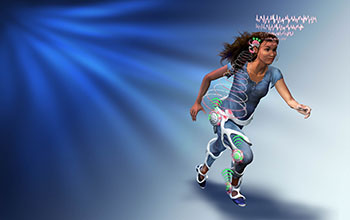Multimedia Gallery
Futuristic brain-computer interface
This illustration, inspired by cutting-edge research supported by the National Science Foundation's (NSF) Directorate for Engineering, shows an example of what the next generation of brain-machine interfaces might look like. The illustration depicts a woman using a futuristic brain-machine interface, a suite of microelectronics and a lower limb exoskeleton to navigate freely through her environment. The woman may be using the device to restore lost function or to augment her natural abilities. The headset contains a non-invasive electroencephalography (EEG) device, an integrated computer chip that records and translates brain activity into digital signals and transmitters that wirelessly send commands to the exoskeleton. Sensors on the exoskeleton provide feedback about the body and the environment to control systems in real time, enabling more seamless integration of the technology and the user.
More about this image
Putting on a brain-machine interface may someday become as routine as pulling on a pair of pants. Already almost 100,000 Americans use cochlear implants, a type of brain-machine interface that connects directly with the nervous system. And now, retinal implants, devices that allow the blind to see, are becoming more common.
NSF-supported research is increasing understanding of the brain and creating exciting new opportunities. To learn more, see the NSF Web page Brain power: Bright ideas and smart tools for neuroengineering. (Date of Image: April 2014)
Credit: Nicolle R. Fuller, Sayo-Art LLC
See other images like this on your iPhone or iPad download NSF Science Zone on the Apple App Store.
Images and other media in the National Science Foundation Multimedia Gallery are available for use in print and electronic material by NSF employees, members of the media, university staff, teachers and the general public. All media in the gallery are intended for personal, educational and nonprofit/non-commercial use only.
Images credited to the National Science Foundation, a federal agency, are in the public domain. The images were created by employees of the United States Government as part of their official duties or prepared by contractors as "works for hire" for NSF. You may freely use NSF-credited images and, at your discretion, credit NSF with a "Courtesy: National Science Foundation" notation.
Additional information about general usage can be found in Conditions.
Also Available:
Download the high-resolution JPG version of the image. (1.3 MB)
Use your mouse to right-click (Mac users may need to Ctrl-click) the link above and choose the option that will save the file or target to your computer.

